Explore the historic Capitol Campus gardens on a free botanical tour
If the last time you toured Washington State’s Capitol Campus in Olympia was in grade school, you’re in for a treat. And we’re not talking about anything inside the state Legislature buildings. We’re talking about the beautiful and lovingly preserved historic gardens of the Capitol Campus. From the largest English Oak in the nation to the first cherry trees to bloom each spring, the gardens are a must-visit destination for everyone.
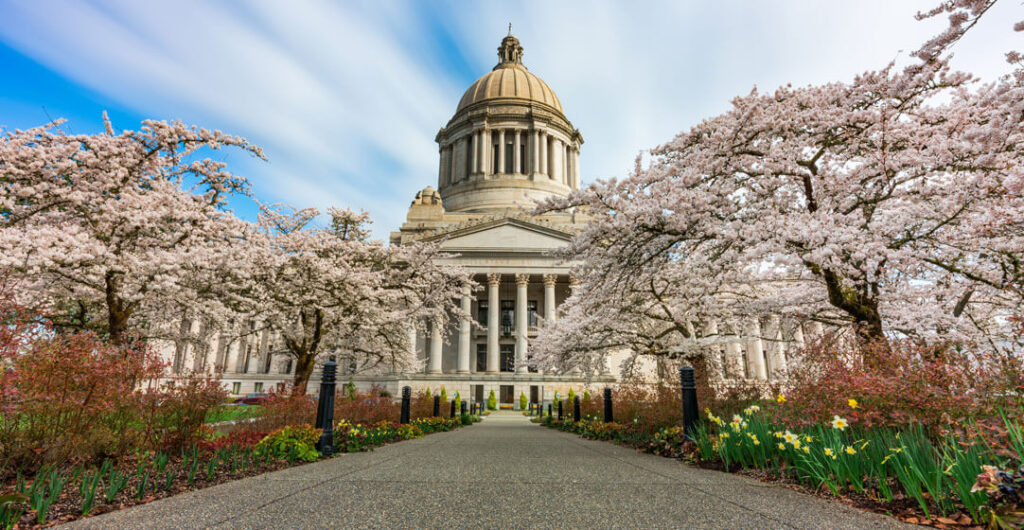
To get the most from your road trip to the Capitol Campus, why not take a free guided botanical tour? You’ll explore the legacy of the famous Olmsted Brothers landscape firm and recent renovations such as the Pollinator Garden and the Sunken Garden. Plus, you’ll get the inside scoop on noteworthy and historic trees.
From early spring to late fall, chances are that your tour guide will be Washington State Department of Enterprise Services (DES) Horticulturist/Grounds Property Manager Brent Chapman, Ph.D.
Chapman oversees the integrity of the Capitol Campus horticultural collections while assisting in developing the vision for improvements in the years to come. He’s also a lifelong gardener who got his start in a vegetable garden on a central Illinois farm. We caught up with Chapman to learn more about the best time to visit the gardens, recent improvements and best seasons for photography.
Campus with a view
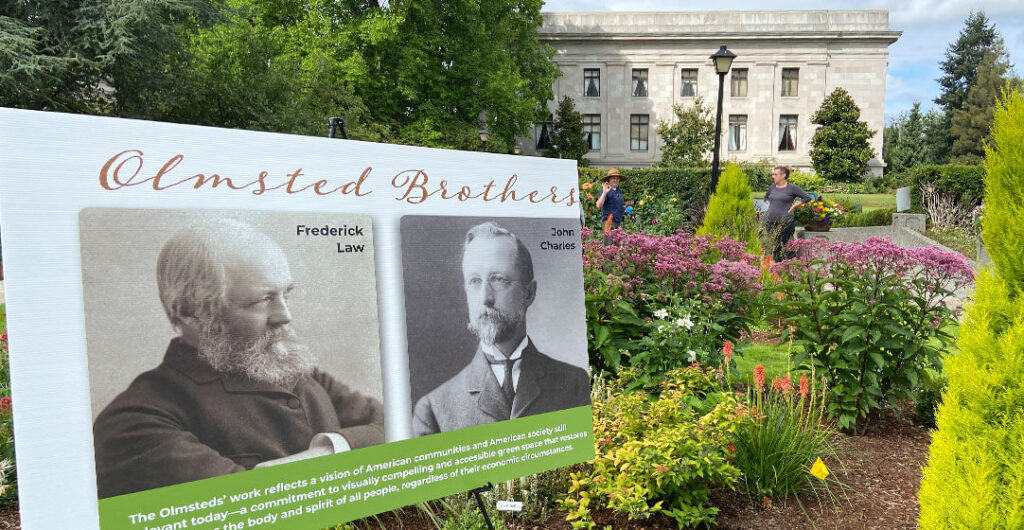
Set on a bluff overlooking Olympia, Capitol Lake and Puget Sound with the Olympic mountains in the distance, the Capitol Campus is a showcase of historic landscape design.
“The Capitol Campus was designed by the Olmsted Brothers landscape firm more than 100 years ago with the aim of using natural landscaping to guide people as they move throughout the campus,” said Chapman. “In Olympia, their landscape design guides people toward our water and mountain views, along pedestrian pathways and towards the magnificent, historic state government buildings on west campus.”
Legacy of the Olmsted Brothers
The Olmsted Brothers isn’t a household name, but many Washingtonians will have experienced their designs in familiar places.
“The Olmsted Brothers designed park and boulevard systems for both Seattle and Spokane, as well as campus plans for the University of Washington and Whitman College,” said Chapman. “They also designed more than 10 state capitol landscapes across the country, including Kentucky, Alabama, Connecticut and New York. And last but not least, their father, Frederick Law Olmsted Sr., designed landscapes for the U.S. Capitol in Washington, D.C.”
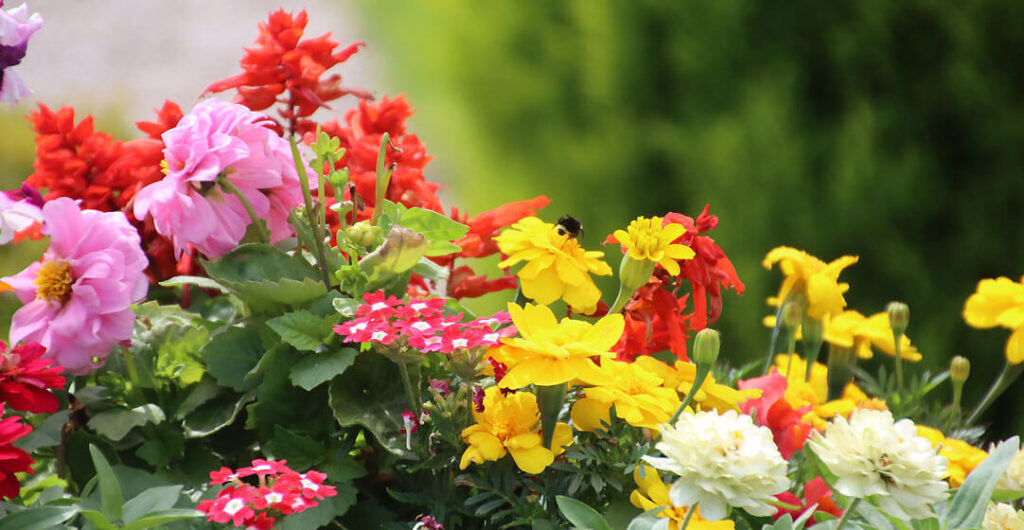
West Campus meets East Campus
The Olmsted Brothers firm were commissioned to design what we now call the West Campus, the area west of Capitol Way, in 1911. But landscaping didn’t get underway until 1927 — and was halted within a few years.
“Due to the Great Depression and World War II, many of the original Olmsted plans weren’t realized at the time,” said Chapman. “However, many elements of the original Olmsted design have been added to campus in recent years and this effort continues in full force today. For example, we recently built landscape beds on West Campus to further realize the Olmsted vision of having a woodland edge to campus.”
Today, the Capitol Campus also includes East Campus, the area east of Capitol Way, as well as five parks managed by DES.
Cherry trees, flowers, and gardens
“As a horticulturalist, I like to say that the gardens are beautiful throughout the year, including winter,” said Chapman. “But for sheer beauty and blooms, spring and summer are spectacular, especially if you’re a photographer. Here are some ideas for places to bring your camera, as well as when to visit.”
Cherry Blossoms: Spring
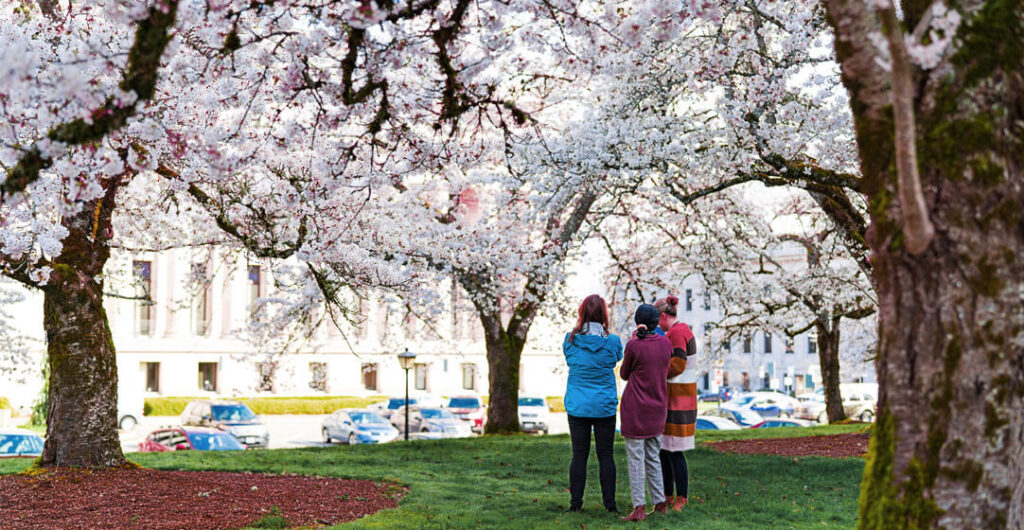
Yoshino cherries, with pale pink to white flowers, are among the first trees to bloom on campus in spring. There are close to 40 in a grove south of the legislative building. There’s also a second small grove northeast of Tivoli fountain by the Isaac Stevens homesite. The timing of cherry blossoms depends on the weather, but they usually bloom in late March and April.
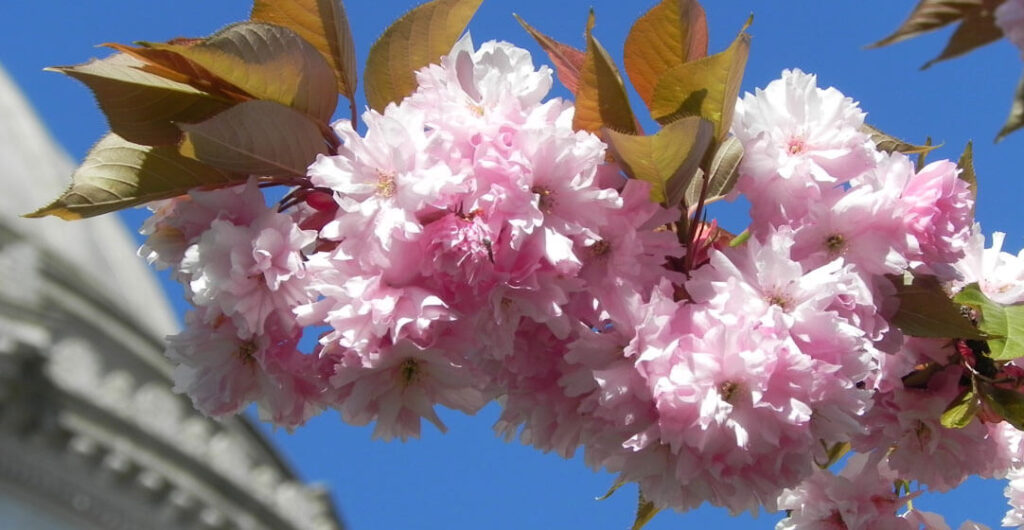
Kwanzan cherries, which you’ll also see on campus, have cotton candy pink flowers. They line Cherry Lane, the street east of the Temple of Justice and the Legislative Building. They are Japanese flowering cherries and don’t bear fruit. They bloom a bit later than the Yoshino cherries, usually in April or early May.
Edible Berry Plants: Summer
Edible blueberry plants thrive on campus. You’ll find them in a variety of locations, drawing birds in that are seeking a quick snack.
Pollinator Garden: Spring through late Fall
Rest assured that you won’t be the only visitor to this garden. Butterflies, bees, hummingbirds, moths and other pollinators will be on-hand, making for great photo opportunities. The Pollinator Garden is a recent addition to the East Campus. It includes eight learning stations created by Woodland Park Zoo.

Witch-hazel: Winter
Blooming witch-hazel is a low-maintenance plant that blooms in late December through February, which makes it popular among Northwest gardeners. Its bright yellow or orangish flowers keep the gardens looking vibrant in the depth of winter.
Hellebore: Winter
Also blooming in winter is hellebore, a hearty perennial plant with showy flowers. It often peaks in February.
Sunken Garden: April through October
The recently renovated Sunken Garden contains the highest concentration of blooming plants on campus and ADA-accessible walkways. It was designed by the Olmsted Brothers and for many decades contained only roses. In 2019, DES received funding to renovate the garden to add ADA access and create a layout that better reflects the original Olmsted Brothers design, plus perennials that are resistant to deer grazing. (Deer frequently visit campus for a bite to eat.)
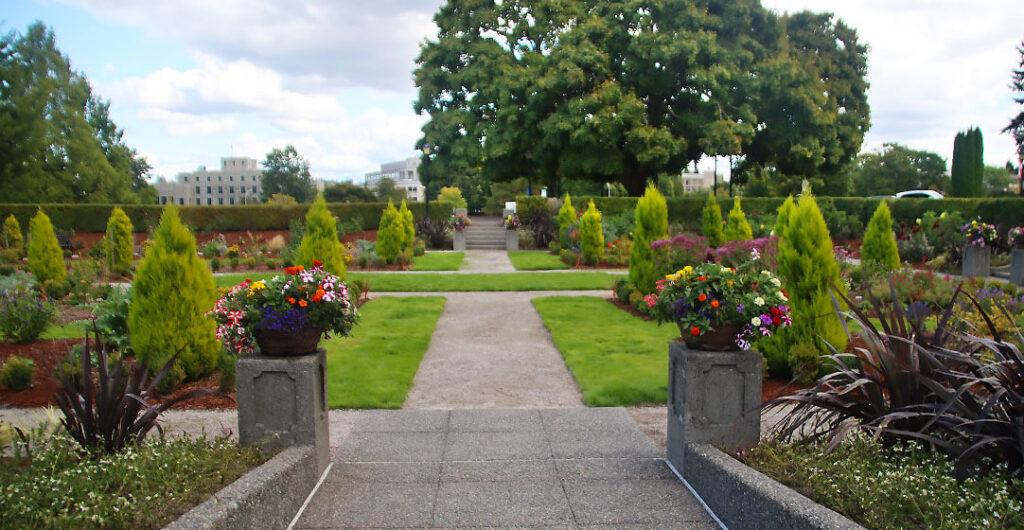
Dahlias: Late August through October
The Dahlias in the Sunken Garden are in full bloom in late summer and early fall. They’re planted and maintained by the Evergreen State Dahlia Association.
Chapman shared that the DES team is particularly proud of the renovation of the Sunken Garden, including the installation of ADA-accessible walkways.
“While the original Olmsted design didn’t include ramps or walkways, its pathways — and formal Victorian lines — made it possible to seamlessly integrate ADA-accessible walkways into the design,” he said. “It goes to show that you can’t give up on historic landscapes; they can grow and change in ways that the original design team didn’t imagine but that meets our vision for today.”
Historic trees and origin stories
Who planted the National Champion English Oak on West Campus, the largest of its kind in the country?
Despite the DES team’s research efforts, that remains a mystery.
“While it’s no secret that the Olmsted Brothers loved trees, they didn’t plant our English Oak, which stands at 96-feet tall with a trunk four-feet thick,” said Chapman. “By English Oak standards, it’s a teenager, a youthful 110 years old. Most likely, it was planted circa 1913-1914 by someone who was part of the early construction of the campus. Landscaping, guided by the Olmsted Brothers’ plan, didn’t begin until close to 15 years after the English Oak was planted. We still haven’t solved this mystery.”
In addition to the largest English Oak in the country, here are some of the other noteworthy trees you can see during your tour:
- Saucer Magnolia: A garden hybrid developed strictly for ornamental purposes, these small trees originated from Chevalier Étienne Soulange-Bodin, an officer in Napoleon’s army. He hybridized two Chinese magnolia species to create the saucer magnolia, which first flowered in 1826. A saucer magnolia near the southeast entrance to the Legislative Building is known as the “sine die tree” because its annual early-March blooming coincides with the end of the Legislature’s 60-day session. (Sine die is Latin for “without a day.”)
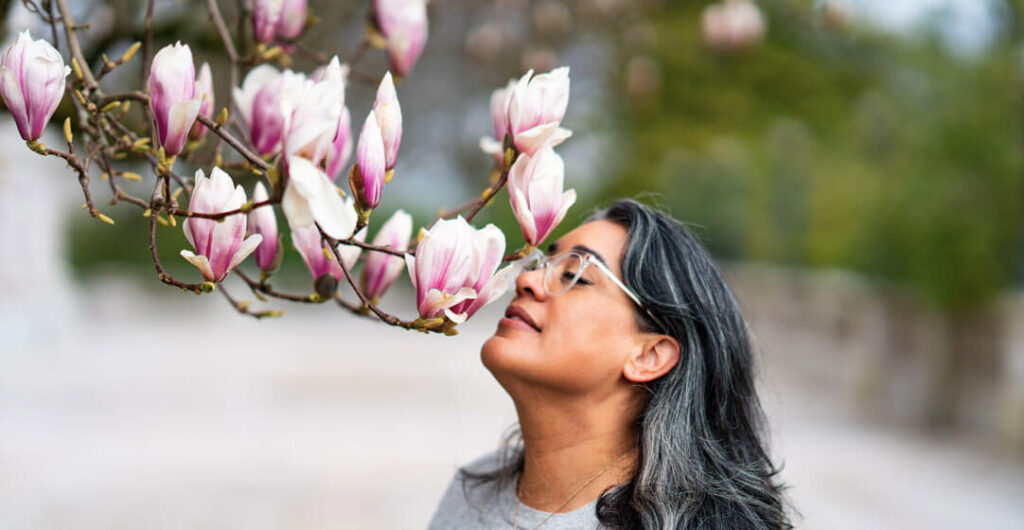
- American White Elm: The large white elm on West Campus is a cutting from a Massachusetts white elm. Legend has it that Gen. George Washington was standing under a white elm in Cambridge, Massachusetts, when he took command of the Continental Army on July 3, 1775. It’s believed that a cutting from that same tree made its way to the Capitol Campus and was planted on the 200th anniversary of Washington’s birth.
- Big Leaf Maple: You’ll find five towering big-leaf maples with mossy trunks on campus, some with licorice fern growing on their trunks. True to its name, the Big Leaf Maple has leaves larger than any other maple, often the size of a plate. They turn golden in the fall. But these towering trees aren’t the tallest in the state. Washington’s tallest Big Leaf Maple is in the Mount Baker National Forest.
- Bush Butternut/White Walnut: This tree is named after Black pioneer George Bush, who led wagon trains from Missouri across the Oregon Trail to establish the first non-Indigenous American settlement in the Washington Territory. The original Bush butternut tree on his farmland was 176 years old when it collapsed from age in 2021. The campus tree was a sapling from the original, taken years earlier. It began producing nuts in 2014.
- Washington Moon Trees: The Capitol Campus is home to four Washington “Moon Trees”—Douglas Firs. During the 1971 Apollo 14 moon mission, astronaut Stuart Roosa transported hundreds of tree seeds with him into lunar orbit, including Douglas fir seeds that were germinated back on earth by the U.S. Forest Service. The resulting seedlings were planted throughout the U.S., including one near the intersection of Capitol Way and South Diagonal. In 2020, three additional moon tree seedlings were planted, grown from cuttings from the original.
Paying tribute to Washingtonians
Among the contemporary additions to the Capitol Campus are several memorials that pay tribute to the citizens of Washington.
“Each memorial has its own unique garden and landscape design,” said Chapman. “These include the World War II Memorial, the Vietnam Veterans’ Memorial east of the Insurance Building, the Korean War Memorial on a plaza east of the main campus and a Law Enforcement Officer Memorial north of the Temple of Justice. Each offers a beautiful setting for quiet reflection.”
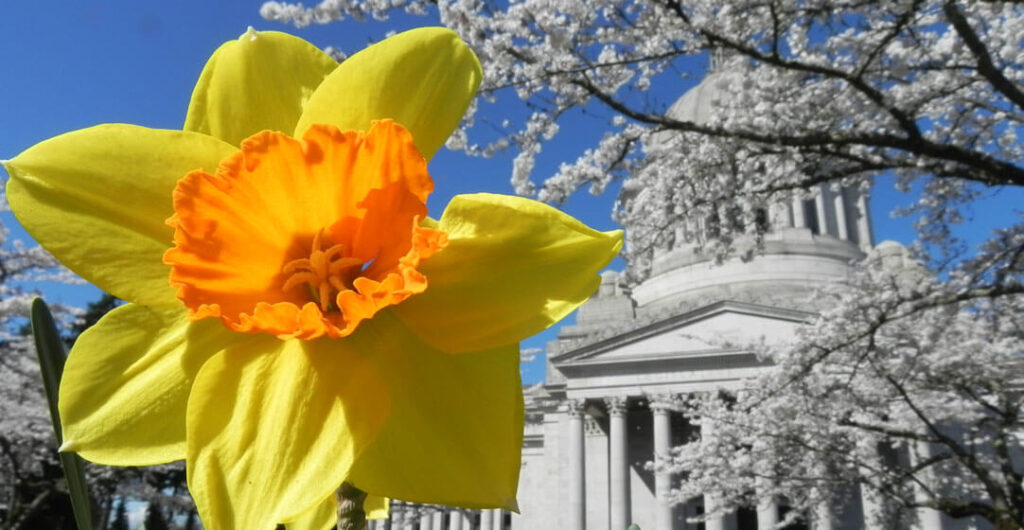
Evolving Capitol Campus vision
Year-round, Chapman and his team are focused on all corners of the landscape.
“Our current work includes adding more trees and plants on West Campus to further fulfill the original Olmsted vision,” explains Chapman. “But we’re continuously adding more trees to serve as the next generation and to replace those lost to storm damage or old age. We’re also adding more plantings for pollinators. Throughout the year, we continue to select plantings that will thrive in the local climate, especially those that require fewer or no pesticides. Lastly, we’re always looking at ways to increase seasonal color, especially during the wintertime.”
Managing a historic garden
The management of the Capitol Campus landscape is governed by the U.S. Department of the Interior Historic Landscape guidelines, which designates 55 acres (about twice the area of Chicago’s Millennium Park) of the West Campus as a National Historic District. When plants and landscape hardscape materials are either replaced or added within the historic district, careful consideration is given to ensure the original landscape intent is honored.
“During a horticultural tour, you’ll hear more about the Olmsted legacy, plus background about the memorials,” said Chapman. “We’ll share details about how the landscape is cared for, and the intricacies of managing a historic landscape. Plus, you’ll learn up-close about how people, plants and spaces are all interconnected in landscape design.”
“I invite everyone to come visit and schedule a free tour — the Capitol Campus is open to all,” continued Chapman. “As a horticulturalist, it’s an honor to share my lifelong love of plant diversity and how horticulture can improve our well-being with visitors from near and far.”
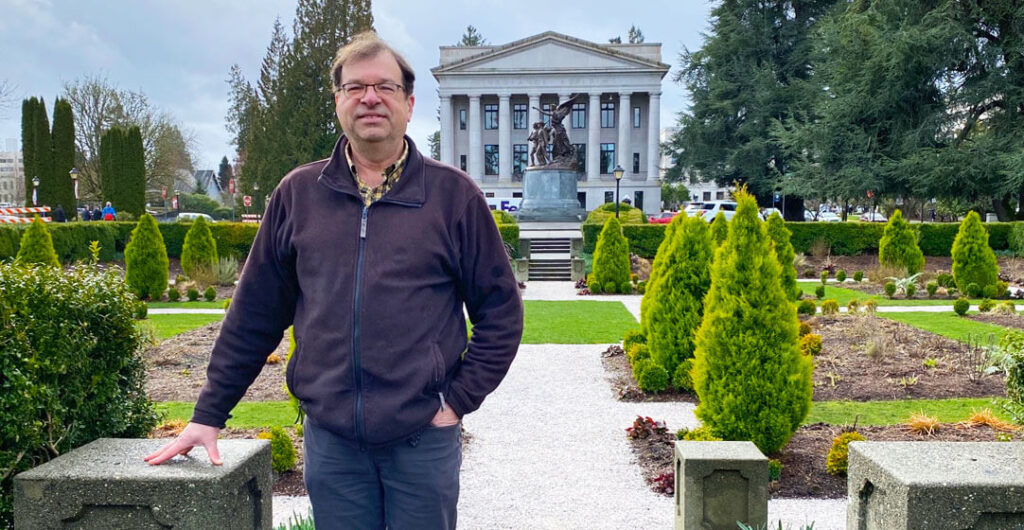
Visit Olympia’s Capitol Campus
Even though work on the Capitol Campus began almost 100 years ago, it’s still green and growing. A renewed focus on sustainability, moving toward pesticide-free maintenance, planting more native species and adding planting for year-round color and vibrancy are all part of the management of the grounds. If you’re interested in horticulture and landscape design — or if you simply love beautiful gardens — be sure to reserve a spot on a free botanical tour.
Book a tour
Botanical tours of the Capitol Campus grounds are by appointment only. Please email the Capitol Campus Horticulturist or call (360) 972-0753 to schedule. Botanical tours can be for individuals or groups of up to 25 people.
AAA Benefit: Members save on Olympia hotels when booking AAA rates! Browse AAA-Approved hotels in Olympia and book here.
—Written by Suzanne Lee
—Top photo: Washington State Department of Enterprise Services

Road Trip Tips
Before you go: Get ready for your road trip with a AAA Membership. Get peace-of-mind on the road plus travel and insurance services and much more.
Save on hotels and rental cars: Unlock savings on hotels with a AAA membership. Plus, AAA members save up to 20% with Hertz.
Save on car insurance: AAA members save up to 8% on car insurance.
Get battery service: AAA Mobile Battery Service uses state-of-the-art technology to accurately diagnose battery-related problems. We’ll even replace your battery with a brand-new one if necessary, at a special member price.
Save with AAA member discounts: AAA membership gives you access to exclusive entertainment discounts nationwide.









